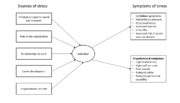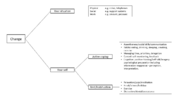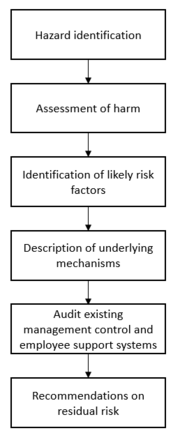How stress management improves the effectiveness of the employees
Stress affects the way we work and our ability to be efficient and effective. The people who work are a very important resource when managing work or projects and it is important to ensure their wellbeing such that they can perform their duties in a project. Therefore stressed employees can effect the outcome of a project, either by losing out on their effectiveness and delaying the project or in worst case losing the ‘’human resource’’ completely. Based on this, stress management is important to consider when working with projects. Real life examples of stress happening are e.g. when the whole world shut down because of the ongoing pandemic. It required change in where and how to work. Change in the communication between coworkers. The whole work/life balance was wrought up. Some companies have handled it well while other companies have been struggling. The changes the pandemic has brought has been a cause for stress both at the office and when working from home. Therefore managers have had to manage stress to keep their employees efficiency and effectiveness up. Changes causes stress whether it is working conditions or restructuring of the organizations. As a project manager, a project will always have changes happening. The project rarely runs smoothly and adjustments have to occur. Therefore in a position as a project manager, stress needs to be managed to handle the changes and the employees. If the king falls, the war is lost. Therefore, it is important that the projectmanager manages the stress of not only their employees but also themselves. Using tools in e.g. time management and communication it is possible to manage stress not only for the project manager but also their employees while keeping them happy. Managing stress eliminates uncertainty and keeps the project steady.
Contents |
What is stress - Basic information about stress
Most people have probably experienced a situation where they felt they were not in control. Examples of stressed situations could be too much work, too many appointments, economic issues or your dog ate something bad and has to go to the vet. Stress is the body’s survival reaction to unexpected happenings. When a stressful event occurs, for example a university student having to deliver in an assignment the next day, stress hormones are released which triggers the fight or flight system, making the student able to respond to the stressful situation. A common way of looking at stress is the following statement: ‘’Stress is the feeling of being overwhelmed or unable to cope with mental or emotional pressure.’’[1] Says the mental health foundation. You can call stress a survival instinct. Stress is often related to mental health. It can have both positive and negative effects depending on the situation the person is in. It can help people through fearful situations, and the stress hormones will usually disappear after the stressful situation is over. It can also work against people and deteriorate them physically and mentally if the person is unable to cope with the stress over a longer duration of time.
If you are experiencing overwhelming amount of stress you should seek help with a medical professional who in turn can help you find local resources to help you.
Stress identifiers
Sometimes stress is not easy to identify since it is not always clear instances that causes stress. Sometimes stress is like standing in a shower and slowly turning up the heat, not realizing how warm the shower is. Stress also affects the person differently and people have different thresholds, but there are certain identifiers to look for when experiencing stress[2].
- Psychological signs
- Emotional signs
- Physical signs
- Behavioral signs
Psychological signs could be concentration or anxiety issues while emotional signs could be feeling more irritated or frustrated than normal. Physical signs could be bodily changes like blood pressure or illness while behavioral signs could be poor self-care or the need to rely on substance abuse.
Different types of stress
As mentioned earlier stress can have different effects on a person, both positive and negative. Below is described 4 different types of stress .
- Acute stress – short term stress with either a positive or negative effect depending on the situation.
- Chronic stress – long term stress which can start affecting the mental and physical health.
- Episodic acute stress – A type of acute stress where the stressful situations keep happening causing distress.
- Eustress – A positive type of stress where the person is energized by the situation for example when racing.
What causes stress
When stressful situations occur what causes the stress are called stressors . Stressors can be external and internal. External stressors could for example work, school, financial or relationship issues whereas internat stressors could be negative thoughts and unrealistic expectations. As stated earlier, people have different thresholds. These thresholds might be dependent on the persons background and physical properties. What one person finds easy to work around might be hard work for another. Therefore it is important to respect how people react differently to stress.
One stressor is that change causes stress as it takes people out of their comfort zone. Especially organizational change can bring the employees out of balance, disrupting their working patterns. According to a paper by Barbara Wisse and Ed Sleebos organizational change would cause an increasing level of self-reported stress among staff members and medication to combat stress also increased. When change occurs, the employees will experience uncertainty in their work methods, some might even find it a threat to their everyday. This increases their stress levels if not managed properly. Therefore, when creating changes either within a company or when working, it is important to manage it properly, not only the individual, but there needs to be a proper change management plan executed to ensure the employees feel a safe transition. Another type of stress is occupational stress, as things such as job satisfaction or work pressure can affect the individual. According to a journal about stress in information system professionals, people experienced stress and burnouts depending on factors such as age and gender, but also deadlines, coworkers, performand and job security.
How stress affects project management
According to a paper by Alan Patching and Rick Best, Regardless of the cause of stress, it can decrease the workplace performance . As mentioned earlier stress affects people differently. Imagine a situation where an employee is dealing with the effects of stress, and this results in them being unable to communicate properly with their teammates. The employee’s performance starts deteriorating and they could be unable to keep up with their deadlines. All these negative aspects will bring down the productivity of the individual, but this is not the only issue. Considering the amount of teamwork and cooperation employees conduct not only internally but also externally with customers or suppliers, the reduced performance of an individual can affect the people around them. This means, that with the stress of an individual, the whole team can be affected. A specific term comes to mind, when looking at the after effects of stress. Burnouts is a psychological syndrome response to chronic emotional and interpersonal job stressors . Employees who are burned out can experience physical health issues such as headaches, sleep disturbances and chronic fatigue. This is turn will result in lower productivity and effectiveness. The employee will possibly work less for the organization and their work quality will go down. With this in mind, a project manager has to focus on time, money and resources management which are important when running projects. Even with project time buffers, a project risks getting delayed. Now the question is, what about including the reduced performance in risk management, then you as a project manager would be prepared in case their performance goes down. Now imagine the stress of the employee being so severe over longer time and it has resulted in physical duress that led to an employee going on sick leave. If an employee goes on sick leave because of stress, it can take a long time to rebuild their strength. They can be gone for months, years or even quit their job . Therefore an important resource is temporarily unavailable or lost and it might be necessary to hire new replacements to the lost resources. Hiring new people requires on boarding and training, while their performance in the beginning is low until they become adjusted to the new work environment. When you are working with a time limited project, there might not be time to onboard new employees, which means as a project manager you might have to accept the quality of work might going down or the need to hire expensive consultants. This might in turn make the customers unhappy.
Project management and stress
It is common knowledge that managing projects is no easy task. There are many aspects of project management touching subjects within purpose, people, complexity and uncertainty. These aspects includes resource management such as people, economy and time.
XXX Describe This topic discusses how project management also is stressful. And how it is important to stress manage not only the employees but the project manager himself, to accommodate all the changes which can happen. XXX
Who is responsible for managing stress
This topic discusses who is actually responsible for managing the stress of the employees. Should the company manage their employees? Is it a waste of money? Is it up to one self to make sure you don’t burn out.
XXX Incorporate this in project management and stress XXX
Stress management tools
After going through reasoning as to what stress can do to the individual and the aftereffects, it is necessary to look at possible tools to prevent stress or manage you or your stressed employees. The tools represented in this article are relatively simple tools including time management, communication, individual management and risk management.
Time Management
The first tool is time management. According to the ‘’time and management reference’’ Time management and stress are closely related. To ensure being able to keep track of the overall project plan, it is important to ‘’micromanage’’ the tasks needed to be done on a daily basis. Unexpected events happen, and as a project manager you will have to counter whatever happens so the project can still run smoothly. The first step in time management is planning your day in advance. At the end of each day structure how your next day will look like. Answering emails takes time and is sometimes a chore. Therefore set a specific hour or two a day where you will answer and look through emails. Update your calendar so your coworkers know when to book you for a meeting. Also do remember, it is okay to say no to a coworker, if you have other important deadlines to reach.
The next step is routine meetings. Meetings can take up a lot of your day, especially in an open office where people drop in time to time. Organize meetings on a daily or weekly basis depending on the need. Also make sure that whatever you have to discuss is planned in advance, such that it can be an effective meeting.
The third step is meeting the deadlines. It is easy to say yes to assignments, but being able to complete them all is another topic. In project management deadlines are quite important, as the plan might get postponed, which will cost money and resources. Make sure you and your employees are able to meet the deadlines necessary to complete the project in time.
The fourth step is prioritizing your work and failure to do so is a waste. Together with planning the previous day a you should prioritize the assignments you have to do. Most important first and less important last. As seen in figure XX this is a simple time management form from the book ‘’time and management reference’’. You list your priorities and when you have to do them. People are different, but visualizing your plan might help you.
By following these four steps it is possible to keep track of your assignments, and will help you reduce stress as it gives some sort of control over a possible chaotic day.
XXXreference of picture, insert pros and cons of toolXXX
Individual Management
As an individual it is possible to make changes to lessen your stress. Based on figure XX it is possible to change two overall aspects. Either your situation or your self. If your situation is causing you stress, for example at work or in your home, you should try to remove yourself from the situation or change it, so it stops working as a stressor. There are certain cases where the individual might not find it possible to remove themselves from the situation, for example being in a project with a uncooperative coworker. As a project manager it is your job to ensure your team is able to work efficiently together.
The other aspect is changing oneself. As a project manager you can mostly have workshops to help educate your employees how to cope with stressors through workshops and open communication. Changes one can make to themselves is gaining healthy habits such as eating and sleeping regularly or exercising and taking their necessary vacations.
XXXreference to image, pros and cons of toolXXX
Risk management - The six stages
When managing stress, there can be many factors, which means it is impossible to counter all stressors that can happen during your project work. Therefore it is important to look into several important factors to be able to navigate where the highest severity can happen. A method called ‘’A risk assessment strategy – six stages’’ is described below.
- First you need to assess the risk of stress. What is the risk of stress happening. What types of stressors are happening. This helps you assess the situation.
- Secondly you have to assess what the risk of illness can occur. How will the stressors affect the individuals and how severe is the stress that can happen for your employees.
- Thirdly you have to assess the extent of exposure. Which employees are affected by the different stressors and how many are affected.
- Fourth you need to understand how the stressors work on the individuals.
- Fifth you need to identify current stressor management systems in your business or create new ones to support the employees that needs help.
- Sixth you have to start managing based on the severity and portion of people affected by the stressors. The stressors with the most negative outcome on your project needs to be prioritized.
The Figure six stages represents the different steps a project manager should conduct through risk assessment of stress.
XXXinsert pros and cons of this toolXXX
Conclusion
XXXWrite a conclusion last summing up everything XXX
XXX Remember to fix all references also in images XXX
Benefits of managing employee stress
This topic will explain what benefits one can receive from managing employee stress.
XXXDepending on words left, describe this, if not exclude it XXX
Annotated Bibliography
- ↑ UK Mental health foundation (2021). An article about the definition of stress.External link
- ↑ Scott, Elisabeth (2020). An article defining stress.External link




